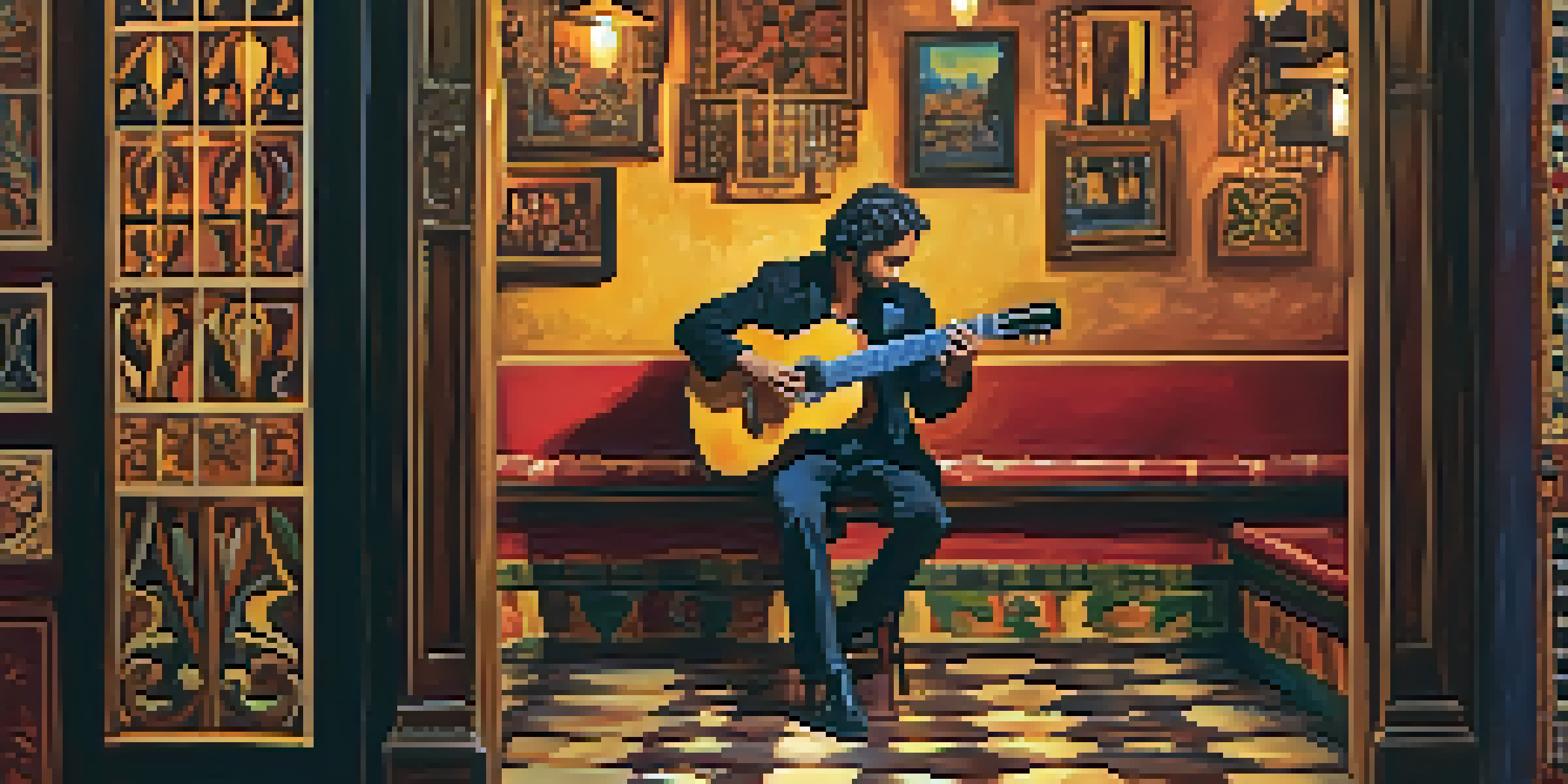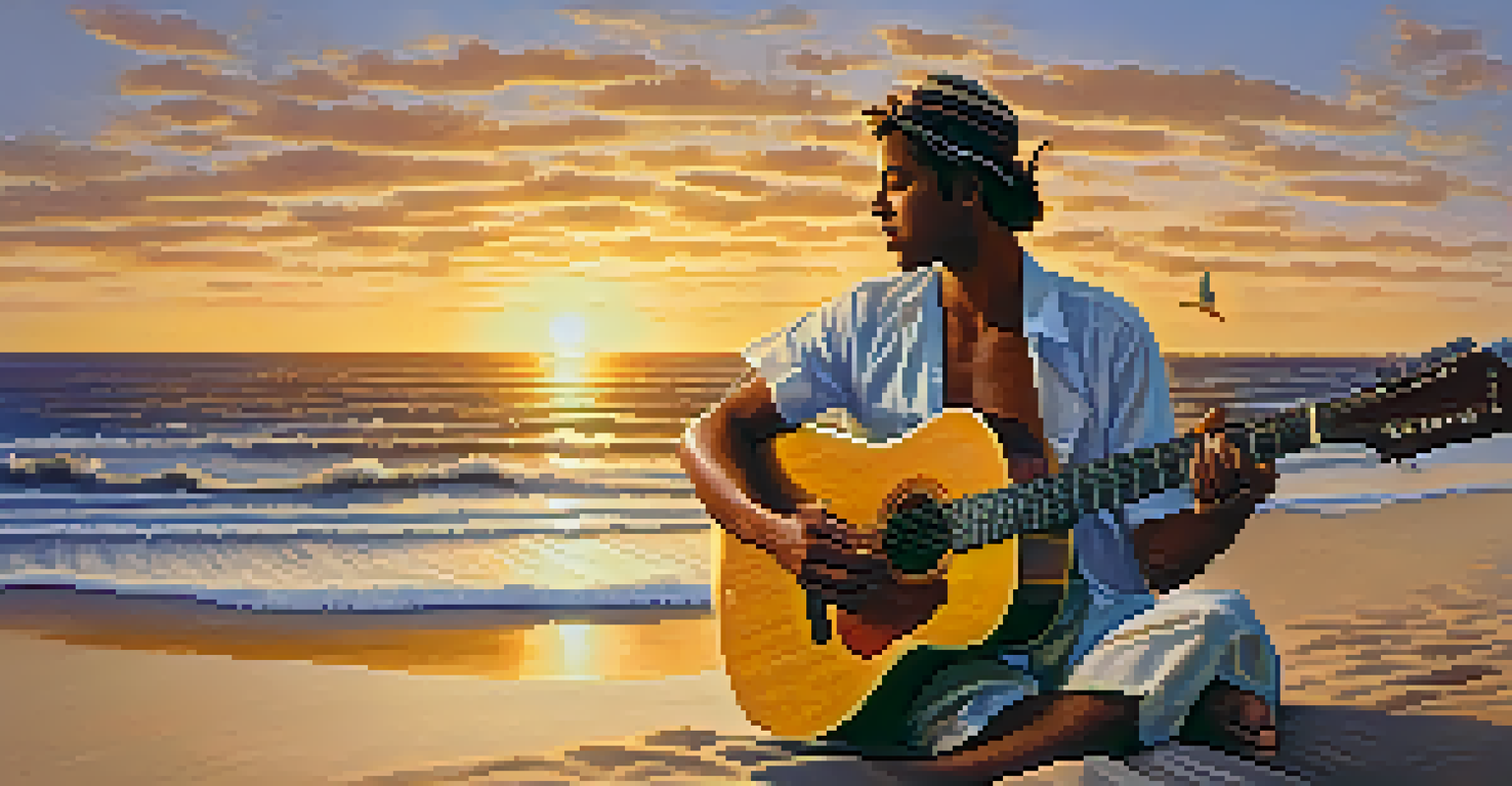Guitar Styles as Expressions of Cultural Diversity

The Guitar: A Global Instrument of Expression
The guitar is more than just a musical instrument; it's a canvas for cultural expression. Across continents, various styles emerge, each telling its own story through sound. From the flamenco guitars of Spain to the blues guitars of America, the instrument transcends borders, resonating with local traditions and histories.
Music is the universal language of mankind.
Each culture brings its unique flavor to guitar playing, shaping how melodies are created and performed. For instance, in Latin America, you might hear the vibrant rhythms of the mariachi guitar, while in Africa, the fingerpicking styles of the kora create a hauntingly beautiful sound. These differences highlight the rich tapestry of human experience and creativity.
As we explore the diverse styles of guitar playing, we also uncover the cultural identities and histories that each one represents. The guitar becomes a bridge, connecting musicians and listeners alike to their roots and the world around them.
Flamenco: Passion and Tradition from Spain
Flamenco guitar, originating from the Andalusian region of Spain, is a dynamic mix of passion, rhythm, and emotion. This style is characterized by intricate fingerpicking and strumming patterns, often accompanied by dance and singing. The intensity of flamenco reflects the cultural heritage of the Romani people and their influence in Spain.

The heart of flamenco lies in its improvisation, allowing guitarists to express their feelings spontaneously. This improvisational nature means that each performance is unique, much like the stories and experiences of those who play it. It's not just music; it's a profound expression of identity and emotion.
Guitar as a Cultural Canvas
The guitar transcends borders, reflecting diverse cultural identities and histories through various playing styles.
Through flamenco, we witness a celebration of cultural resilience and artistry. The music often serves as a form of storytelling, capturing the joys and sorrows of life in a way that resonates deeply with audiences worldwide.
Blues: The Voice of the American Experience
The blues guitar style emerged from the African American experience in the Deep South, deeply rooted in the struggles and triumphs of its people. Characterized by its expressive bends and soulful melodies, blues guitar reflects a journey through hardship, often serving as a form of catharsis for both the player and the listener.
Guitar is the best instrument for self-expression.
With its distinctive 12-bar structure and use of call-and-response techniques, blues music tells stories that resonate universally. Legends like B.B. King and Muddy Waters pushed the boundaries of guitar playing, influencing countless musicians and genres that followed. The emotional depth found in blues is a testament to its cultural significance.
Blues is not just a genre; it's a movement that shaped modern music. Its influence can be seen in rock, jazz, and even pop music, proving that the guitar is a powerful tool for storytelling and cultural expression.
Bossa Nova: The Sweet Sound of Brazil
Bossa Nova is a fusion of samba and jazz that originated in Brazil during the late 1950s. Characterized by its smooth, laid-back rhythms, bossa nova guitar often features intricate fingerstyle techniques that create a soothing sound. This style reflects Brazil's rich cultural landscape, blending native rhythms with international influences.
The iconic song 'The Girl from Ipanema' exemplifies the bossa nova style, showcasing the guitar's ability to evoke images of sun-soaked beaches and vibrant city life. Guitarists like João Gilberto brought this genre to the forefront, using their instruments to paint vivid pictures of Brazilian culture.
Flamenco and Blues: Emotional Depth
Flamenco and blues guitar styles embody deep emotional expression, resonating with the personal and collective experiences of their cultures.
Bossa nova's gentle melodies and complex harmonies invite listeners into a world of tranquility and beauty. It serves as a reminder of how music can unify diverse cultural elements into something new and captivating.
Celtic Guitar: Echoes of Tradition from Ireland
Celtic guitar music draws deep from the well of Irish and Scottish folk traditions, characterized by its lively jigs and haunting ballads. The guitar often accompanies traditional instruments like fiddles and flutes, creating a rich tapestry of sound that celebrates cultural heritage. Its melodies are steeped in history, often telling tales of love, loss, and adventure.
Fingerstyle techniques are common in Celtic guitar playing, allowing musicians to create intricate patterns that evoke the spirit of the land. The use of alternate tunings adds to the unique sound, making each performance feel like a journey through the rugged landscapes of the British Isles.
Celtic guitar is more than just music; it’s a connection to the past. It invites listeners to explore the folklore and traditions of the Celtic people, reinforcing the notion that music is a vessel for cultural memory.
Reggae: The Rhythms of Jamaica
Reggae guitar, synonymous with the vibrant culture of Jamaica, features a distinctive offbeat strumming style known as 'chopping.' This technique creates a rhythmic foundation that underpins the soulful messages of reggae music. Artists like Bob Marley used guitar to amplify themes of love, resistance, and social justice, reflecting the spirit of their time.
The music often incorporates elements of ska and rocksteady, enriching its rhythmic complexity. The guitar acts as both a rhythm and lead instrument, allowing for a dynamic interplay between musicians. Reggae's infectious grooves encourage a sense of community, inviting everyone to come together in celebration.
Fusion Celebrates Global Diversity
Fusion music blends different guitar styles, highlighting the interconnectedness of cultures and the universality of musical expression.
Through reggae, we see how music can be a powerful tool for social change. The genre's roots in the struggles of the Jamaican people resonate worldwide, illustrating the guitar's role in expressing cultural narratives.
Fusion: Blending Cultures Through Guitar
The fusion of various guitar styles has given rise to innovative genres that celebrate cultural diversity. Musicians such as Carlos Santana blend Latin, rock, and blues elements to create a sound that transcends traditional boundaries. This genre encourages experimentation, allowing artists to explore new sonic landscapes while honoring their roots.
In fusion music, the guitar often takes center stage, showcasing the technical prowess of the player while telling a story that resonates with a global audience. The blending of styles not only reflects individual creativity but also highlights the interconnectedness of cultures in an increasingly globalized world.

Fusion serves as a reminder that music is a universal language. By bringing together diverse influences, it fosters understanding and appreciation, bridging gaps between different cultural narratives.
Conclusion: Embracing Diversity Through Guitar Music
Guitar styles around the world are a testament to the rich cultural diversity that exists within the music community. Each style reflects unique histories, experiences, and emotions, showcasing how the guitar can serve as a powerful medium for cultural expression. By embracing these various styles, we gain a deeper appreciation for the stories they tell.
As we listen to different guitar styles, we not only enjoy the music but also connect with the cultures and communities behind them. This connection fosters empathy and understanding, enriching our lives and broadening our perspectives.
In celebrating the diversity of guitar music, we honor the creativity and resilience of people from all walks of life. Ultimately, the guitar becomes a symbol of unity, reminding us that while our backgrounds may differ, our love for music binds us together.